According to a former Nuclear Regulatory Commission Chief, the beach in front of San Onofre Nuclear Generating Station could become a permanent nuclear waste dump. Learn why Edison’s program of storing deadly nuclear waste on the beach is not a “temporary” plan and about a recent almost-accident that underlines how dangerous this is. Cartoonist Jerry Collamer weighs in.
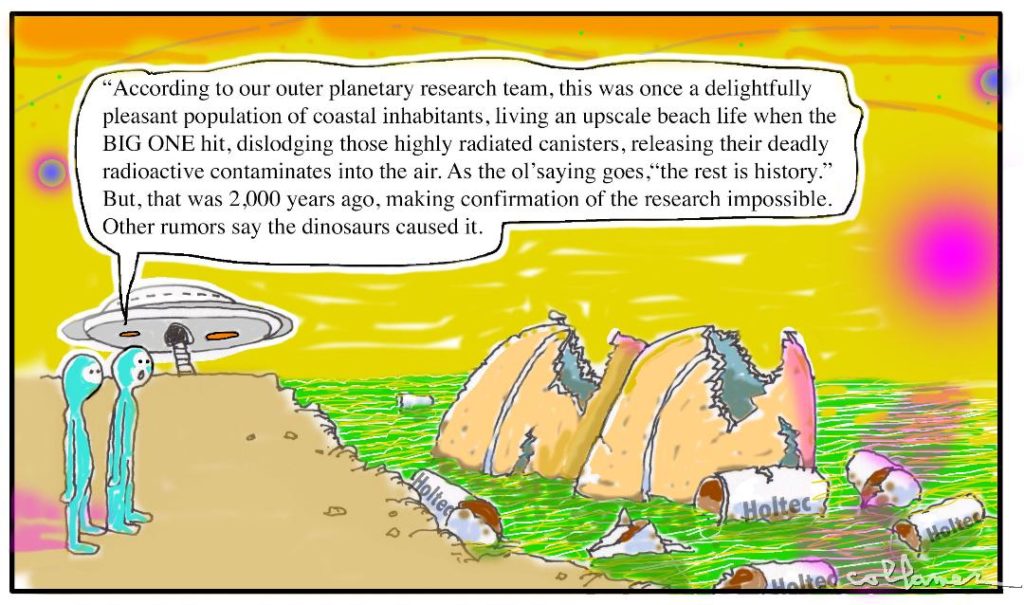

Former NRC Chief Says San Onofre’s Nuclear Waste May Never Be Moved
By Alison St John, Published by KPBS
A former head of the Nuclear Regulatory Commission said Southern California Edison should stop burying nuclear waste next to the beach at San Onofre.
Greg Jaczko was the head of the Nuclear Regulatory Commission in 2012 when Edison shut down San Onofre because of a radioactive leak. He said plans to move the waste elsewhere may never materialize.
Southern California Edison spokeswoman Maureen Brown said the company has now transferred more than 26 canisters, about one-third of the still highly radioactive spent nuclear fuel remaining in cooling ponds at San Onofre, into dry cask storage on site. The canisters are loaded with spent fuel rods, moved across the site and lowered into vertical casks set in concrete. Only the 74 concrete lids are visible, lined up right next to a seawall.
“According to our outer planetary research team, this was once a delightfully pleasant population of coastal inhabitants, living an upscale beach life when the BIG ONE hit, dislodging those highly radiated canisters, releasing their deadly radioactive contaminates into the air. As the ol’ saying goes, “the rest is history.” But, that was 2,000 years ago, making confirmation of the research impossible. Other rumors say the dinosaurs caused it.” – Divined by Jerry Collamer
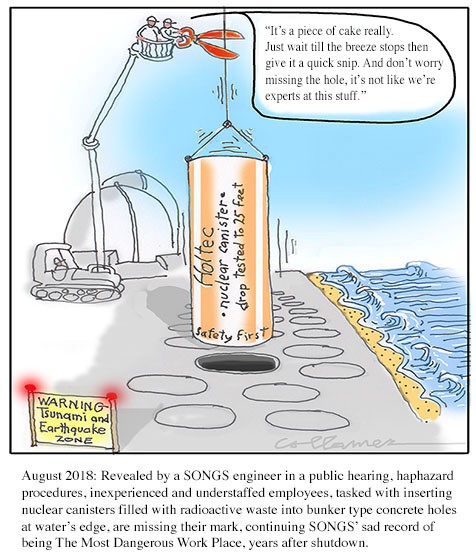
“Our commitment is to support any reasonable and safe way to move fuel out of San Onofre, whether it’s a permanent repository, one of these two projects, or something not yet on the horizon,” Palmisano said.
But Jaczko said don’t count on it.
“Because, quite frankly, once they get loaded, I don’t see them ever taking those canisters out of there,” Jaczko said. “Realistically, they are not going to move them out, so those permits will be extended, the operational period will be extended on indefinitely and you will have a de facto burial site there.”
httpvh://youtu.be/TR7wpsvOENk
Former NRC Chief Says San Onofre’s Nuclear Waste May Never Be Moved – KPBS
The problem of what to do with nuclear waste is a national one because the federal government has not agreed on a long-term storage site, Jaczko said.
“There’s a tendency to want to make the problem go away, emotionally and mentally, and when you bury things, it’s easier mentally to not worry about them,” Jaczko said. “Very quickly, people came to this conclusion that the way you solve this problem is you find a place where you can bury and forget: it’s literally called ‘bury and forget.’ You bury the waste and you forget about it.”
httpvh://youtu.be/xTybvl8Ubwc
KPBS Interview With Former Nuclear Regulatory Commission Chief Greg Jaczko – KPBS
Sea Level Rise
Tom English is a retired electrical engineer who has advised the U.S. government and industry on nuclear waste disposal. He lives in Carlsbad, 25 miles south of San Onofre. Moving spent fuel rods out of cooling ponds and into dry storage casks is a good idea, English said, but not if the bottom of those casks are just feet above mean high tide levels.
“If you are involved with high-level nuclear waste disposal, the first thing you think of is to keep it away from water, because the water allows the radionuclides to spread through the environment, causing all sorts of havoc, wrecking ecosystems, cancer, etc.,” English said.
The company that designed the storage system, Holtec International, made sure the bottom of the buried casks is just above mean high tide level.


On its website, Holtec states, “Our goal is to maintain the canisters in such a pristine state that they can be readily hauled off to New Mexico, as soon as the Federal Government is able to so order.”
But the federal government has failed to fulfill its promise of finding a permanent nuclear waste storage site, and promises of interim storage sites are just that: promises with no guarantees.
English said sea-level rise may well overtake Holtec’s projected timetable and flood the casks before they can be hauled off. He compares the design with the faulty steam generator design which caused San Onofre to be shut down in the first place in 2012.
“You have a design here that is even more irresponsible than the design of the steam generators, and they’re presenting the design as beautiful,” he said.
Monitoring, Inspection
Holtec and Edison are still working on ways to inspect and monitor the casks for cracking, which English said is required under the license.
“Those aren’t real right now,” he said. “It’s like, ‘We’re going to figure that out later.’ We should say, ‘Look, you guys can’t do anything until you can figure out how to inspect and monitor.’”
Edison’s Palmisano revealed in March that a pin had broken in one of Holtec’s new casks, but that the industry has not figured out how to put the spent fuel rods back into the cooling ponds to see if they have a problem.
“The real challenge, as we understand it today — and nobody has had to do it yet — is the re-flood,” Palmisano said, referring to reflooding the fuel rods, which he said are 200 to 300 degrees Celsius. Water boils at 100 degrees Celsius.
“It’s certainly technically possible,” he said.
Palmisano said it would take a couple of years to get regulatory approval from the NRC to move the spent fuel back into the pools. So Edison is continuing to transfer the waste into casks with a different design.
Jaczko has little confidence the NRC will do what’s needed to protect public safety.
“Over the years, political appointees, people like me — you’ve tended to have people appointed in those top positions, the commission itself, who have had more of a focus on the industry than they have on the public, and I think that’s unfortunate,” he said.
Part of the problem, Jaczko said, is that the industry does not want to take responsibility for the waste, now that the nuclear fuel is no longer making money for them.
Theoretically storing nuclear waste until the federal government finds a permanent repository should be safe, Jaczko said, but the federal government has not found a permanent storage site.
“A monitored storage approach is perfectly fine if you find the right site and you accept the responsibility,” he said. “If you take a company like Edison, they are no longer generating electricity at San Onofre. They no longer want to have the responsibility for maintaining waste. It’s not a business.”
“You have these companies that have spent decades generating this waste and now that they’re done generating electricity, they don’t want to have to deal with a problem that could last longer than the actual time period that they generated electricity,” he said.
Alternatives
Recently, the House passed a bill that could open the door to allow nuclear waste to be sent to interim storage sites. Companies in New Mexico and Texas have begun the process of applying for a license.
But that is a false promise, said Torgen Johnson, an urban planner who lives in Solana Beach. Johnson said he visited New Mexico where communities were attending scoping meetings on the nuclear waste storage proposals.
“This promise from Edison that they’ve got a quick out, that they’re going to can it when the opportunity comes and move it to New Mexico, is a falsehood,” Johnson said. “There is no clear place that’s going to welcome this.”
He said a company would welcome it, but he saw unanimous opposition from the community.
“We’re promised something that can’t be delivered,” Johnson said. “Safety cannot be delivered because the canisters are not monitored, are not repairable, and are susceptible to chloride-induced cracking.”
httpvh://youtu.be/9kRPWSAHjBg
The San Onofre Settlement Is Fake News
The Mesa
Jaczko and English agree that a better alternative to burying the waste by the beach would be to store it close by, but on higher ground, on a mesa on the east side of the freeway, and also in Camp Pendleton.
“Get it away from the water, so if they move it half a mile eastward, there’s a mesa that’s about 80 feet higher than the current facility — so that gets it out from the groundwater and also takes care of the sea-level rise problem,” English said.
Retired Adm. Len Hering, a former commander of Navy Region Southwest in San Diego, agreed that putting the fuel on the mesa would be the correct strategic decision. He said the decision to bury the spent fuel next to the beach was not based on adequate risk assessment, either for Camp Pendleton or for the 8 million people living within a 50 miles radius.
Hering said he has approached officials at the Pentagon and the Department of Energy to discuss the possibility of moving the waste to higher ground on base.
“As regional commander, if there were environmental concerns, it was very easy to go to the Secretary and discuss those issues in a completely different and open fashion,” Hering said. “I don’t see that happening today.”
State Lands Commission EIR
Next week, the California State Lands Commission holds hearings in Oceanside on a Draft Environmental Impact Report on the decommissioning of San Onofre. The report will guide the state’s approval of future decommissioning activities at San Onofre. However, the report does not analyze the options of the already approved nuclear waste storage site, because, the draft report explains, “its operation is under the exclusive authority of the U.S. government.”
Edison plans to complete the transfer of the remaining spent fuel rods into dry casks by next year. Then the company hopes to dismantle the spent fuel pools and most of the remaining structures on the site. But not the spent fuel storage. That has a permit from the California Coastal Commission to remain until 2035.
“You have to recognize that this is not a short-term solution,” Jaczko said. “Whatever is going to be done with this spent fuel is probably what’s going to happen with this fuel for decades, if not centuries. So you have to think about this as a long-term solution.”
“I think the first thing they should do right now, is stop loading casks,” Jaczko said.
Updated 15 August 2018

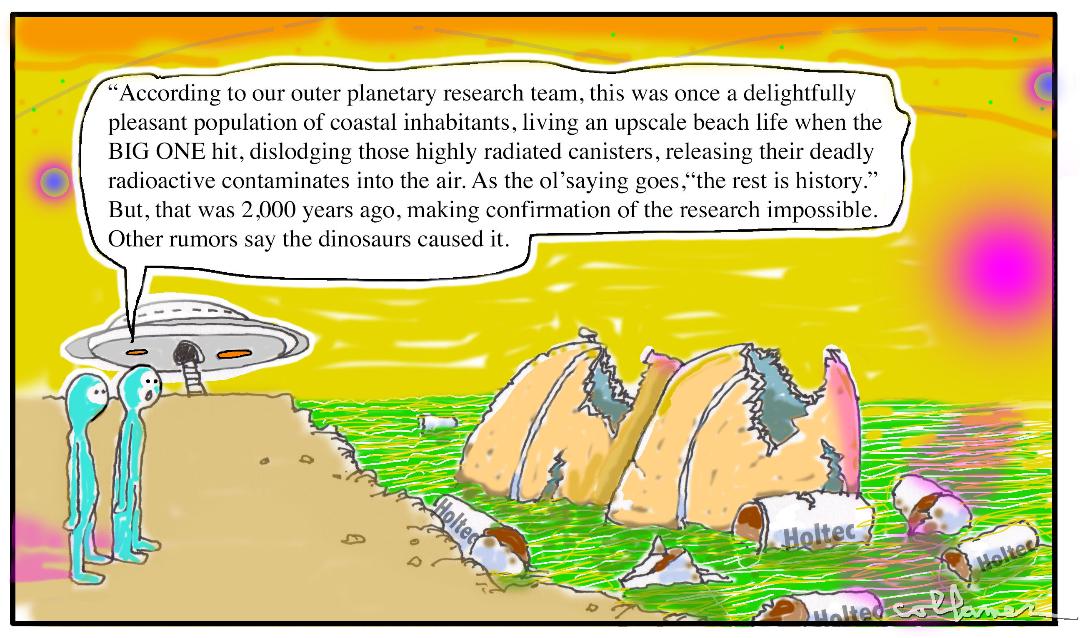


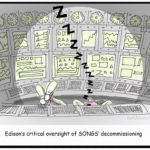

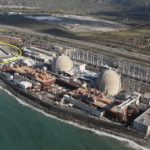






Pingback: To August 18 – nuclear and climate news – Australia and International | Nuclear Australia
Pingback: San Onofre Nuclear Waste Dangers Compound | WilderUtopia.com
Pingback: EcoJustice Radio – San Onofre as Nuclear Waste Dump – Episode 20 | WilderUtopia.com